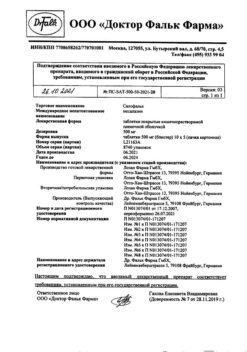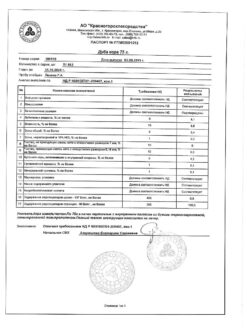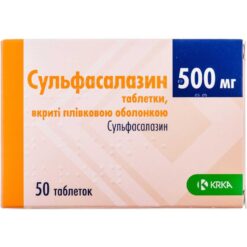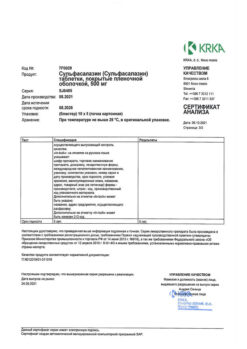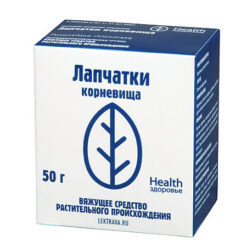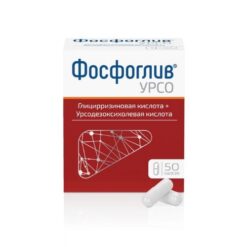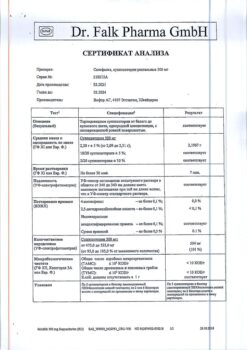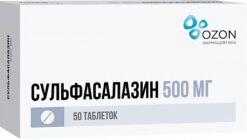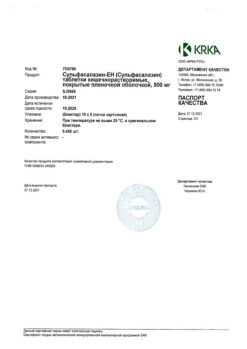No products in the cart.
Resolor, 2 mg 28 pcs.
€80.44 €67.03
Out of stock
(E-mail when Stock is available)
Description
Pharmacodynamics
Mechanism of action
Prucalopride is a dihydrobenzofurancarboxamide that increases intestinal motility. Prucaloprid is a selective, high-affinity agonist of 5HT4-serotonin receptors, which most likely explains its action on intestinal motility. Binding to other types of receptors in vitro was observed only at concentrations of the substance that exceeded its affinity for 5HT4 receptors by at least 150 times.
Pharmacokinetics
Absorption
Prucaloprid is rapidly absorbed; after a single oral dose of 2 mg, maximum concentration (Cmax) is reached after 2-3 hours. Absolute bioavailability after oral administration exceeds 90%. The bioavailability is not affected by taking the drug with meals.
Distribution
Prucalopride is distributed throughout the body; the volume of distribution in equilibrium (Vdss ) is 567 l. Binding to plasma proteins is approximately 30%.
Metabolism
Metabolism of the drug in the human liver in vitro is very slow, and only small amounts of metabolites are formed. After human oral administration of 14C-labeled prucalopride, 8 metabolites are detected in small amounts in the urine and feces. The major metabolite (R107504, formed by O-demethylation of prucalopride and oxidation of the resulting alcohol to carboxylic acid) is less than 4% of the administered dose of the drug. About 85% of the drug remains unchanged, as indicated by radioactive labeling studies; the metabolite R107504 is present in plasma in small amounts.
The majority of the orally administered dose of the active ingredient is excreted unchanged (approximately 60% by the kidneys and at least 6% in the feces). Excretion of unchanged pruncalopride by the kidneys includes passive filtration and active secretion. The plasma clearance of prucalopride averages 317 ml/min and the final T1/2 is approximately 1 day. The equilibrium state is reached after 3-4 days of drug administration, with minimum and maximum equilibrium plasma concentrations of 2.5 and 7 ng/ml, respectively, when taking prucalopride at a dose of 2 mg once daily. When administered once daily, the drug’s k-factor ranges from 1.9 to 2.3. Pharmacokinetics of prucalopride is linearly dose-dependent up to 20 mg/day. With long-term administration of the drug once daily, its pharmacokinetics are independent of the duration of administration.
Particular categories of patients
Population pharmacokinetics
A population pharmacokinetic analysis showed that total clearance of prucalopride correlated with creatinine clearance (CK) and was independent of patient age, body weight, sex, or race.
Elderly Patients
In elderly patients taking the drug at a dose of 1 mg once daily, the plasma Cmax and area under the concentration-time curve (AUC) of prucalopride were 26% and 28% greater, respectively, than in younger patients. This difference may be related to impaired renal function in the elderly.
Renal dysfunction
In comparison with patients with normal renal function, patients with mild (CK 50-79 mL/min) and moderately severe (CK 25-49 mL/min) renal dysfunction had a 25% and 51% increase in plasma concentration of prucalopride after a single dose of 2 mg, respectively. In patients with severe renal dysfunction (CKR less than 24 mL/min), plasma concentrations of prucalopride were 2.3 times higher than in healthy subjects.
Hepatic dysfunction
About 35% of prucalopride is excreted extrarenally, so hepatic dysfunction is unlikely to change the pharmacokinetics of the drug in a clinically significant way.
Children
After a single oral dose of 0.03 mg/kg of prucalopride in children aged 4-12 years, the Cmax of the drug was the same as after an adult dose of 2 mg, and the AUC of the unbound fraction of the drug was 30-40% lower than in adults and was independent of the age of children. The mean T1/2 of the drug in the terminal phase is approximately 19 h in children (range 11.6-26.8 h).
Indications
Indications
Rezolor is intended for the symptomatic treatment of chronic constipation in women in whom laxatives have not provided sufficient effect in eliminating symptoms.
Pharmacological effect
Pharmacological effect
Pharmacodynamics
Mechanism of action
Prucalopride is a dihydrobenzofuran carboxamide that enhances intestinal motility. Prucalopride is a selective, high-affinity 5HT4-serotonin receptor agonist, which most likely explains its effect on intestinal motility. Binding to other types of receptors in vitro was observed only at concentrations of the substance exceeding its affinity for HT4 receptors by at least 150 times.
Pharmacokinetics
Suction
Prucalopride is rapidly absorbed; after a single oral dose of 2 mg, the maximum concentration (Cmax) is achieved after 2-3 hours. Absolute bioavailability after oral administration exceeds 90%. Taking the drug with food does not affect bioavailability.
Distribution
Prucalopride is distributed throughout the body, the volume of distribution at steady state (Vdss) is 567 l. Plasma protein binding is approximately 30%.
Metabolism
Metabolism of the drug in the human liver in vitro is very slow, and only a small amount of metabolites is formed. Following oral administration of 14C-labeled prucalopride in humans, 8 metabolites are found in small amounts in urine and feces. The main metabolite (R107504, formed by O-demethylation of prucalopride and oxidation of the resulting alcohol to carboxylic acid) constitutes less than 4% of the administered dose of the drug. As studies with a radioactive label have shown, about 85% of the drug remains unchanged; metabolite R107504 is present in plasma in small quantities.
Removal
Most of the orally administered dose of the active ingredient is excreted unchanged (approximately 60% by the kidneys and at least 6% in the feces). Excretion of unchanged prucalopride by the kidneys involves passive filtration and active secretion. The clearance of prucalopride from blood plasma averages 317 ml/min, the final T1/2 is approximately 1 day. An equilibrium state is achieved after 3-4 days of taking the drug, and when taking prucalopride at a dose of 2 mg 1 time per day, the minimum and maximum concentrations in blood plasma at steady state are 2.5 and 7 ng/ml, respectively. When taken once a day, the k coefficient of the drug ranges from 1.9 to 2.3. The pharmacokinetics of prucalopride is linearly dependent on the dose in the range of up to 20 mg/day. With long-term use of the drug once a day, its pharmacokinetics do not depend on the duration of administration.
Special categories of patients
Population pharmacokinetics
Population pharmacokinetic analysis showed that the total clearance of prucalopride correlates with creatinine clearance (CC) and is independent of the age, body weight, sex or race of patients.
Elderly patients
When the drug was taken by elderly patients at a dose of 1 mg 1 time per day, the Cmax of prucalopride in plasma and the area under the concentration-time curve (AUC) were 26% and 28%, respectively, greater than in younger patients. This difference may be due to decreased renal function in older adults.
Renal dysfunction
Compared with patients with normal renal function, in patients with mild (creatinine clearance 50-79 ml/min) and moderately severe (creatinine clearance 25-49 ml/min) renal impairment, the plasma concentration of prucalopride after a single dose of 2 mg was increased by 25% and 51%, respectively. In patients with severe renal impairment (creatinine clearance less than 24 ml/min), the plasma concentration of prucalopride was 2.3 times higher than in healthy people.
Liver dysfunction
About 35% of prucalopride is eliminated extrarenally, so impairment of liver function is unlikely to clinically significantly alter the pharmacokinetics of the drug.
Children
After a single oral dose of prucalopride at a dose of 0.03 mg/kg in children aged 4-12 years, the Cmax of the drug was the same as after taking the drug in adults at a dose of 2 mg, and the AUC of the unbound fraction of the drug was 30-40% less than in adults and did not depend on the age of the children. The average half-life of the drug in the terminal phase is approximately 19 hours in children (range 11.6-26.8 hours).
Special instructions
Special instructions
The main route of excretion of prucalopride is through the kidneys. For patients with severe renal impairment, the recommended dose is 1 mg.
Severe diarrhea may reduce the effectiveness of oral contraceptives, and the use of additional methods of contraception is recommended to prevent a decrease in the effectiveness of oral contraceptives. Impaired liver function is unlikely to have a clinically significant effect on the metabolism and systemic exposure of prucalopride in humans.
There are no data on the use of the drug in patients with mild, moderate or severe hepatic impairment; therefore, a lower dose is recommended for patients with severe hepatic impairment.
The drug contains lactose monohydrate, so the drug should not be taken by patients with congenital lactase deficiency, lactose intolerance or glucose-galactose malabsorption.
For prucalopride, neither the rebound phenomenon nor the development of dependence was detected. A study of the effect of prucalopride on the QT interval at therapeutic (2 mg) and supratherapeutic (10 mg) dosages showed no significant differences compared with placebo in terms of QT interval values.
The incidence of QT-related adverse events and ventricular arrhythmias was low and comparable to that observed with placebo.
Impact on the ability to drive vehicles and other mechanisms that require increased concentration
There have been no studies of the effect of prucalopride on the ability to drive a car or drive machinery. In some cases, the use of Rezolor has been associated with the development of dizziness and weakness, especially in the first days of treatment, which may affect the ability to drive a car and operate moving machinery.
Active ingredient
Active ingredient
Prucaloprid
Composition
Composition
1 tablet contains:
Active ingredients:
prucalopride succinate 2.642 mg, which corresponds to the content of prucalopride 2 mg.
Excipients:
tablet core:
lactose monohydrate – 165.458 mg,
microcrystalline cellulose – 30 mg,
colloidal silicon dioxide – 0.4 mg,
magnesium stearate – 1.5 mg,
film coating pink – 7 mg.
Composition of pink film coating in percentage by weight:
hypromellose 6 cP – 40%,
red iron oxide dye (E172) – 0.09%,
titanium dioxide – 23.88%,
macrogol 3000 – 8%,
triacetin – 6%,
lactose monohydrate – 22%,
indigo carmine (E132) – 0.02%,
iron oxide yellow dye (E172) – 0.01%.
There are 7 tablets in the blister.
The package contains 2 blisters.
Pregnancy
Pregnancy
Pregnancy
Experience with prucalopride during pregnancy is limited. Cases of miscarriage have been reported in clinical studies, although given the presence of other risk factors, the association of these events with the use of prucalopride remains unproven.
Animal studies have not revealed direct or indirect adverse effects on the course of pregnancy, embryo/fetal development, childbirth and postnatal development of the offspring. Resolor is not recommended for use during pregnancy. During treatment with prucalopride, women of childbearing potential should use adequate methods of contraception.
Lactation period
Prucalopride is excreted in breast milk, however, when used in therapeutic doses, the drug is unlikely to have an effect on newborns/infants. Due to the lack of data on use in nursing mothers, the drug is not recommended for use during breastfeeding.
Fertility
Animal studies have not revealed any effect of the drug on the fertility of males or females.
Contraindications
Contraindications
Hypersensitivity to the active ingredient or any excipient;
impaired renal function requiring dialysis;
perforation or obstruction of the intestine due to anatomical or functional disorders of the intestinal wall, mechanical intestinal obstruction, severe intestinal inflammation, for example, Crohn’s disease, ulcerative colitis and toxic megacolon/megarectum;
congenital lactase deficiency, lactose intolerance, glucose-galactose malabsorption.
With caution: the use of the drug in patients with severe and clinically unstable concomitant diseases (diseases of the liver, lungs, cardiovascular, neurological, endocrine diseases, mental disorders, cancer, AIDS) has not been studied. Caution should be exercised when prescribing Rezolor to patients with such diseases. In particular, the drug should be used with caution in patients with a history of cardiac arrhythmia or coronary heart disease.
Side Effects
Side Effects
The most common adverse reactions when using the drug Rezolor were headache and adverse reactions from the gastrointestinal tract (abdominal pain, nausea, diarrhea), each of which was observed in approximately 20% of patients.
Adverse reactions developed mainly at the beginning of treatment and usually disappeared after a few days, without requiring discontinuation of treatment. Other adverse reactions were observed sporadically. Most adverse reactions were mild or moderate in severity.
At the recommended dose of prucalopride 2 mg, the following adverse reactions were reported in clinical studies, the frequency of which is indicated as:
very often (> 1/10);
often (> 1/100, < 1/10);
uncommon (> 1/1000, < 1/100);
rare (> 1/10000, < 1/1000);
very rare (<1/10000), including isolated cases.
From the central nervous system: very often – headache; often – dizziness; infrequently – tremor.
From the cardiovascular system: infrequently – palpitations.
From the gastrointestinal tract: very often – nausea, diarrhea, abdominal pain; often – vomiting, dyspepsia, rectal bleeding, flatulence, pathological bowel sounds; infrequently – anorexia.
From the genitourinary system: often – pollakiuria.
General: often – weakness; infrequently – fever, poor health.
Interaction
Interaction
In vitro data indicate a weak ability of prucalopride to interact, and at therapeutic concentrations it is unlikely to affect the metabolism of concomitantly used drugs by cytochrome enzymes. Although prucalopride may bind weakly to P-glycoprotein (P-GP), at clinically relevant concentrations it does not inhibit the activity of (P-GP).
Ketoconazole, a potent inhibitor of CYP3A4 and P-glycoprotein, at a dose of 200 mg twice daily increased the AUC (area under the concentration-time curve) of prucalopride by approximately 40%. This effect is too small to be clinically significant and is most likely due to inhibition of active transport of prucalopride in the kidneys by P-glycoprotein.
The same interactions as with ketoconazole can also be observed with other active P-gp inhibitors, such as verapamil, cyclosporine A and quinidine. Prucalopride is likely also transported in the kidneys by other carriers. Theoretically, inhibition of all transporters involved in the active secretion of prucalopride in the kidneys (including P-glycoprotein) could increase its systemic exposure by 75%.
Studies involving healthy volunteers showed no clinically significant effect of prucalopride on the pharmacokinetics of warfarin, digoxin, ethyl alcohol and paroxetine. With the simultaneous use of prucalopride and erythromycin, the concentration of the latter in the blood plasma increases by 30%. The mechanism of this interaction is not completely clear, but available data indicate that it is most likely not the result of a direct effect of prucalopride, but rather a consequence of the high variability in the pharmacokinetics of erythromycin itself.
Probenecid, cimetidine, erythromycin and paroxetine at therapeutic doses did not affect the pharmacokinetics of prucalopride.
Rezolor should be used with caution concomitantly with drugs that can prolong the QTc interval.
Atropine-like substances may reduce the effects of prucalopride mediated through the HT4 receptors.
No interaction with food was detected.
Overdose
Overdose
A study in healthy volunteers showed that prucalopride was well tolerated when the dose was increased to 20 mg once daily (10 times the recommended therapeutic dose).
Overdose may result in symptoms due to increased known side effects of the drug, including headache, nausea, and diarrhea.
There is no specific antidote for Rezolor. In case of overdose, symptomatic and supportive therapy should be provided if necessary. Large fluid losses due to diarrhea or vomiting may require correction of electrolyte imbalances.
Storage conditions
Storage conditions
At a temperature not exceeding 25 °C, in original packaging
Shelf life
Shelf life
3 years
Manufacturer
Manufacturer
Janssen-Cilag S.p.A., Italy
Additional information
| Shelf life | 3 years |
|---|---|
| Conditions of storage | At a temperature not exceeding 25 °C, in the original package |
| Manufacturer | Janssen-Silag S.p.A., Italy |
| Medication form | pills |
| Brand | Janssen-Silag S.p.A. |
Related products
Buy Resolor, 2 mg 28 pcs. with delivery to USA, UK, Europe and over 120 other countries.



